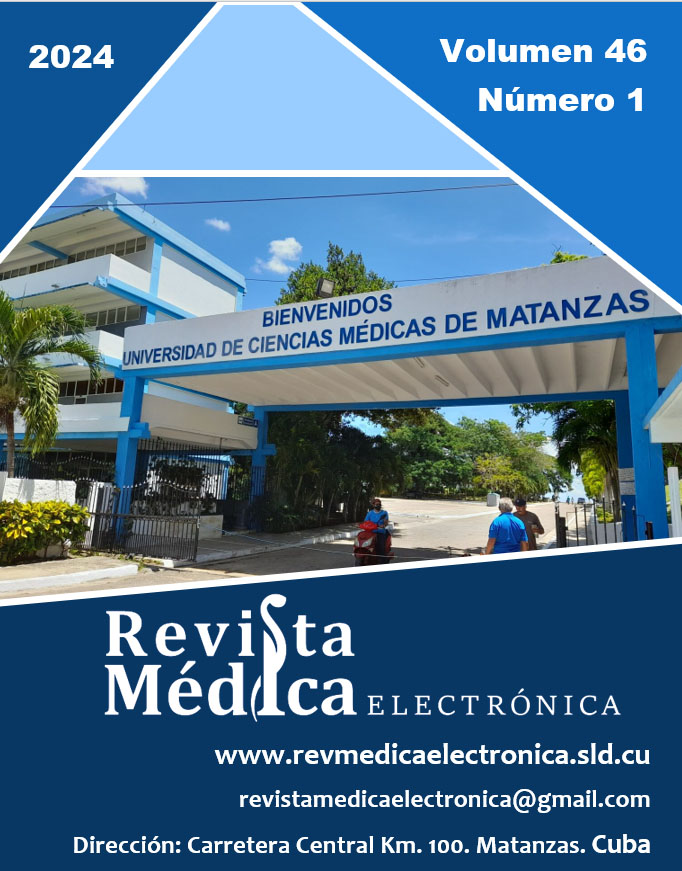Percepción de la probabilidad de fallecimiento posvacunación por rebrote de SARS-CoV-2 en Perú
Palabras clave:
contagio, COVID-19, eficacia, percepción, vacunaciónResumen
Introducción: El rebrote de casos de COVID-19 en Perú ha aumentado la preocupación en las personas ante una nueva vacunación.
Objetivo: Describir la percepción de probabilidad de fallecimiento posvacunación de nuevos casos de sars-coV-2 en Perú.
Métodos: Entre enero y marzo de 2024 se realizó un estudio en Ica, Perú, con 28 docentes universitarios vacunados con tres dosis; las dos primeras de Pfizer-BioNTech. Se excluyeron aquellos con vacunación mixta y quienes mostraron dudas sobre el sistema de salud. El estudio calculó la proporción de docentes con un esquema de vacunación uniforme, aplicando una escala Likert y midiendo la consistencia interna con el coeficiente alfa de Cronbach.
Resultados: El grupo femenino superó ligeramente al masculino, con un 61,54 %; el rango de edad más representativo fue el de 45 a 54 años. El 46,43 % recibió tres dosis de la vacuna Pfizer-BioNTech. Solo el 14 % estuvo dispuesto a una nueva vacunación, pese a la alta confianza en la información de salud (89 %). El valor de la escala Likert fue 2,94 puntos, el cual sugirió una diversidad de opiniones. El coeficiente alfa de Cronbach, de 0,94, indicó excelente consistencia interna.
Conclusiones: Hubo diversidad en las actitudes de los docentes universitarios sobre la vacunación. Aunque la mayoría confió en el sistema de salud, existe escepticismo hacia la efectividad de las vacunas y disposición limitada a dosis adicionales ante un rebrote por COVID-19.
Descargas
Citas
2. Wu Z, McGoogan JM. Characteristics of and important lessons from the coronavirus disease 2019 (COVID-19) outbreak in China: Summary of a report of 72314 cases from the Chinese Center for Disease Control and Prevention. JAMA. 2020;323(13):1239-42. DOI: 10.1001/jama.2020.2648.
3. Huang X, Wei F, Hu L, et al. Epidemiology and clinical characteristics of COVID-19. Arch Iran Med. 2020;23(4):268-71. DOI: 10.34172/aim.2020.09.
4. Chan JFW, Yuan S, Kok KH, et al. A familial cluster of pneumonia associated with the 2019 novel coronavirus indicating person to person transmission: a study of a family cluster. Lancet. 2020;395:514-23. DOI: 10.1016/S0140-6736(20)30154-9.
5. Huang C, Wang Y, Li X, et al. Clinical features of patients infected with 2019 novel coronavirus in Wuhan, China. Lancet. 2020;395:497-506. DOI: 10.1016/s0140-6736(20)30183-5.
6. Oliveira Roster KI, Kissler SM, Omoregie E, et al. Surveillance strategies for the detection of new SARS-CoV-2 variants across epidemiological contexts. medRxiv. 2023. DOI: 10.1101/2023.05.09.23289744.
7. Wohl S, Lee EC, DiPrete BL, et al. Sample size calculations for pathogen variant surveillance in the presence of biological and systematic biases. Cell Reports Medicine. 2023;4(5):101022. DOI: 10.1016/j.xcrm.2023.101022.
8. Badr HS, Zaitchik BF, Kerr GH, et al. Unified real-time environmental-epidemiological data for multiscale modeling of the COVID-19 pandemic. Scientific Data. 2023;10(367). DOI: 10.1038/s41597-023-02276-y.
9. Voysey M, Costa Clemens SA, Madhi SA, et al. Single-dose administration and the influence of the timing of the booster dose on immunogenicity and efficacy of ChAdOx1 nCoV-19 (AZD1222) vaccine: a pooled analysis of four randomised trials. Lancet [Internet]. 2021 [citado 26/03/2024];397(10277):881-91. Disponible en: https://pubmed.ncbi.nlm.nih.gov/33617777/
10. Kow CS, Hasan SS. Real-world effectiveness of BNT162b2 mRNA vaccine: a meta-analysis of large observational studies. Inflammopharmacology [Internet]. 2021 [citado 26/03/2024];29(4):1075-90. Disponible en: https://pubmed.ncbi.nlm.nih.gov/34241782/
11. Meggiolaro A, Sane Schepisi M, Nikolaidis GF, et al. Effectiveness of vaccination against SARS-CoV-2 infection in the pre-delta era: A systematic review and meta-analysis. Vaccines. 2022;10(2):157. DOI: 10.3390%2Fvaccines10020157.
12. El Comercio. Denuncian que aplican vacunas expiradas contra la COVID-19 y Minsa responde que proceso es seguro [Internet]. Lima: El Comercio; 2024 [citado 13/02/2024]. Disponible en: https://elcomercio.pe/lima/covid-19-ciudadanos-denuncian-que-aplican-vacunas-expiradas-y-minsa-responde-que-proceso-es-seguro-ultimas-noticia/?ref=ecr
13. Polack FP, Thomas SJ, Kitchin N. Safety and Efficacy of the BNT162b2 mRNA Covid-19 vaccine. New England Journal of Medicine. 2020;383(27):2603-615. DOI: 10.1056/NEJMoa2034577.
14. Logunov DY, Dolzhikova IV, Shcheblyakov DV, et al. Safety and efficacy of an rAd26 and rAd5 vector-based heterologous prime-boost COVID-19 vaccine: an interim analysis of a randomised controlled phase 3 trial in Russia. Lancet. 2021;397(10275):671-81. DOI: 10.1016/S0140-6736(21)00234-8.
15. Dagan N, Barda N, Kepten E, et al. BNT162b2 mRNA Covid-19 vaccine in a nation wide mass vaccination setting. New England Journal of Medicine. 2021;384(15):1412-23. DOI: 10.1056/NEJMoa2101765.
16. Thompson MG, Burgess JL, Naleway AL, et al. Interim Estimates of Vaccine Effectiveness of BNT162b2 and mRNA-1273 COVID-19 Vaccines in Preventing SARS-CoV-2 Infection Among Health Care Personnel, First Responders, and Other Essential and Frontline Workers — Eight U.S. Locations, December 2020–March 2021. MMWR. 2021;70(13):495-500. DO: 10.15585/mmwr.mm7013e3.
17. Cronbach LJ. Coefficient alpha and the internal structure of tests. Psychometrika. 1951;16(3):297-334. DOI: 10.1007/BF02310555.
18. Heinzerling A, Stuckey M, Scheuer T, et al. Transmission of COVID-19 to health care personnel during exposures to a Hospitalized Patient - Solano County, California, February 2020. MMWR. 2020;69(15):472-6. DOI: 10.15585/mmwr.mm6915e5.
19. Arboleda R, Mace Firebaugh CJ, Beeson T, et al. Demographic factors associated with COVID-19 vaccine perceptions amongst healthcare and law enforcement workers. J Contemp Stud Epidemiol Public Health. 2023;4(1). DOI: 10.29333/jconseph/12935.
20. Haddar A, Sellami I, Abbes A, et al. Vaccination day and perceived stress among university teachers. European Psychiatry. 2022;65(S1):S542-3. DOI: 10.1192/j.eurpsy.2022.1388.
21. Zheng C, Shao W, Chen X, et al. Real-world effectiveness of COVID-19 vaccines: a literature review and meta-analysis. International Journal of Infectious Diseases. 2022;114:252-60. DOI: 10.1016/j.ijid.2021.11.009.
22. Peres IT, Bastos LSL, Gelli JGM, et al. Sociodemographic factors associated with COVID-19 in-hospital mortality in Brazil. Public Health. 2021;192:15-20. DOI: 10.1016%2Fj.puhe.2021.01.005.
23. Cesareo M, Tagliabue M, Lopes ME, et al. Framing effects on willingness and perceptions towards COVID-19 vaccination among university students in Italy: An exploratory study. Vaccines. 2023;11(6):1079. DOI: 10.3390/vaccines11061079.
24. Wong JCS, Yang JZ. Risk perception of the COVID-19 vaccines: revisiting the psychometric paradigm. Journal of Risk Research. 2023;26(6):697-709. DOI: 10.1080/13669877.2023.2208142.
25. Rahayuwati L, Mutyara K, Nugraha RR, et al. COVID-19 vaccine perspective among university lecturers and students: A qualitative study of pre implementation of vaccination. Journal of Multidisciplinary Healthcare. 2023;16:1619-29. DOI: 10.2147/JMDH.S416123.
Publicado
Cómo citar
Número
Sección
Licencia
La misma permite:
• Copiar y redistribuir el material publicado en cualquier medio o formato.
• Adaptar el contenido.
Esto se realizará bajo los siguientes términos:
• Atribuir los créditos de los autores e indicar si se realizaron cambios, en cuyo caso debe ser de forma razonable.
• Uso no comercial.
• Reconocer la revista donde se publica.
Se mantienen los derechos de autoría de cada artículo, sin restricciones.







